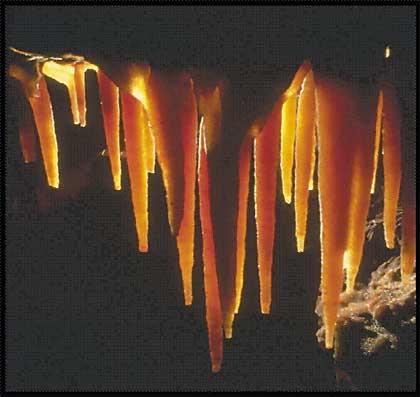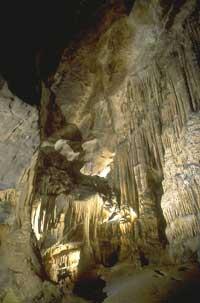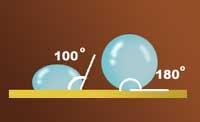Spectacle built by drops
2001/07/29 Roa Zubia, Guillermo - Elhuyar Zientzia
Perhaps the most beautiful contribution of simple drops are the ‘buildings’ that are formed in caves. The limestone abundant in our environment is very suitable for the realization of this type of works. Beautiful structures called karst are created.

Rain traps from the atmosphere the carbon dioxide heard and, through an acid that forms, feeds slowly limestone. This mineral, dissolved in the drops of water, penetrates the holes and, when it appears in a large underground esplanade, accumulates in it forming fascinating structures.
The most famous structures are stalactites and stalagmites, stone needles that protrude from the natural roof and floor, respectively. Normally the drop of water has enough dissolved matter to supply both structures, so they are formed by pairs, that is, under a corresponding stalactite. They can be many meters long. In fact, over time you can join both structures and form a column. It is spectacular the work of a few simple drops after the years.
Groundwater
Nature has many open paths. Let's follow the drops of water. Limestone leaves many slits through which water enters easily. When the esplanades of these slits become caves, drops often come together forming pools and underground lakes.
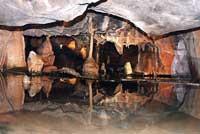
Of course, stalactites on wells do not have lower stalagmites. But not always that the soil is dry. It is a matter of drops of water. If the amount of dissolved matter is low or the flow is very slow, all the ‘load’ of the drops remains in stalactites and it is not possible to perform stalagmites.
But the work of art of the caves is not a mere consequence of leaks. Some drops treat many other types of paths and spend time sifting other structures. For example, when sliding down a wall, the dissolved mineral is gradually precipitated. Thus, the road to a dropper can be marked forming a sheet of stone. And if at the end of the road there are no leaks, the drops can leave sculptures in the shape of a column on the wall.
The water level of the wells is very variable in the caves. When there are heavy rains or as a result of the melting of snow, the level increases and on disembarks drops. But the leaking drops almost constantly reach the well.
As each drop leaves its piece of rock, in wells without exit can reach an unsustainable state. If the limestone is too dissolved, although it is submerged, it begins to precipitate. If water loses carbon dioxide or lowers its temperature, the process is facilitated. The mineral accumulates forming curious underwater structures.
Amazing designs

Thus, for example, coral forms appear on the underwater walls of the well. Sometimes they look like corals or popcorn, others like flowers or grapes (the imagination depends on yourself). If the water level drops, these curious stone structures are exposed. So when a speleologist finds the walls evenly covered with ‘corals’, he knows that place has been covered with water ever.
However, these ‘corals’ do not always need a well to appear. Geologists have analyzed these processes with great enthusiasm, as they claim that there are five ways to produce these types of structures upstream. In the first, the matter that leaves the water when it slides down the wall crystallizes with this form. In the second, they can be formed by irregularities of the wall. In the third, the forms are a consequence of the splashes of the droplet falling into an adjoining well. In the room, the water moves above the wall by capillarity. And in the fifth, ‘coral’ is formed by moisture condensation.
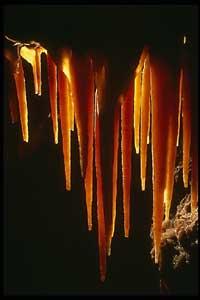
The success of all these explanations has not brought with it many headaches to geologists. But the caves have also found ‘crazy stalactites’ that do not correspond to gravity. These structures are called helictites. It is more difficult to explain how these amazing pendants are created. What are the drops that generate helictites? Quiet. Answer already exists. They are said to go up by capillarity or simply pushing the drafts upwards. Who knows. In any case, they are spectacular.
The lid, the lid, the lid… even though the drops of water fall without being able to sleep, they are not consolable, these drops create beautiful works of art. They need only a few million years to chisel the spectacular cavities of the mountains. However, it takes a few minutes for man to destroy this work. Sometimes it is so in efforts to make the cave visible to all. Therefore, let the mountain itself preserve the ins and outs of nature.
Water droplet dynamics
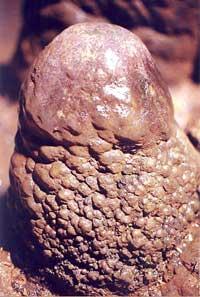
Powerful science deals with very complex and complicated things. But simple everyday problems have always become the origin and excuse of research… And the bustling water dripping into a well when you are asleep is one of those problems that have been studied lately.
The process begins with a concorcho formed by suspended water. From a moment when the bulge has received a lot of liquid, the gout begins to unfold from its union. Finally, the area that makes up the link narrows and breaks. The drop of water falls.
We all know. However, no one knows why a drop sometimes falls and other times a jet of water forms. In addition, it seems that sometimes there is a lot of water and other times it takes little amount of liquid to cause the drop. Is this really true or not? Why will it be? For those who can't sleep it's a nice topic, to think, bore and try to fall asleep.
Others thought too much and gave the drop a use of terror. For example, in many civilizations cold water drops have been used to torture. Gradually the drop was poured over the victim's head and caused great pain (localizable before dying). Where would the idea of this torture come from? Perhaps observing the environment, in everyday life there are thousands of drops willing to fall into appropriate places to disturb.
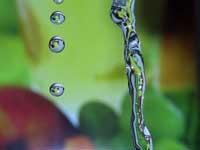
On the other hand, jet control is essential in different technologies. Many printers print with inkjet; if these machines leave spot spots, it is necessary to change the design of the machine. The success of many industrial procedures depends on drops; even those who make DNA chips and use liquid chocolate may lose money if drops are not properly controlled. Therefore, several scientists are seriously working on writing drip formulas.
The problem seems to lie in the surface tension of gout, viscosity, temperature and flow rate. After solving thousands of formulas, the University of Texas concluded that by heating the air around the dropper fewer drops form. Of course (you can think). What did they think they would find?
In research at Purdue University, scientists obtained another outcome that could be predicted; small water spills do not produce regular drips and large ones do. Each type of leak presents a characteristic type of risk. Small spills produce ‘satellite drops’, small and difficult to control. However, if the flow increases too much it can cause the chaos of the drops and some specific water jet.
Published in the supplement Natura de Gara.

Gai honi buruzko eduki gehiago
Elhuyarrek garatutako teknologia




